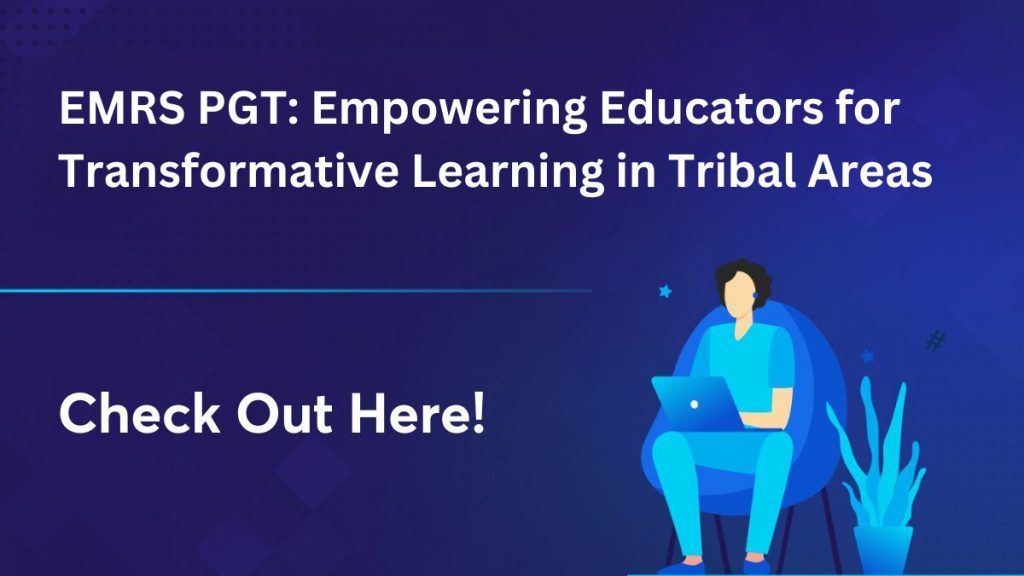The Eklavya Model Residential Schools (EMRS) have become a symbol of educational transformation in tribal areas of India. These schools aim to provide quality education and holistic development to students from tribal communities. In this article, we will delve into the EMRS PGT (Post Graduate Teacher) program, its objectives, eligibility criteria, selection process, and the significant role it plays in empowering educators and nurturing the potential of tribal students.
1. Understanding EMRS PGT
EMRS PGT stands for Eklavya Model Residential Schools Post Graduate Teacher. It is a specialized teaching program initiated by the Ministry of Tribal Affairs, Government of India. The program aims to recruit highly qualified and skilled teachers for teaching postgraduate students in EMRS.
2. Objectives of EMRS PGT
The EMRS PGT program has the following objectives:
- To provide quality education in various subjects at the postgraduate level in EMRS.
- To foster academic excellence and critical thinking among students.
- To create a conducive learning environment for holistic development.
- To promote research, innovation, and advanced learning methodologies.
- To empower teachers to become transformative educators and mentors.
3. Eligibility Criteria for EMRS PGT
To be eligible for the EMRS PGT program, candidates must meet the following criteria:
- They should be Indian citizens.
- They must possess a master’s degree in the relevant subject from a recognized university.
- They should have completed a Master of Education (M.Ed.) or equivalent degree from a recognized institution.
- They should fulfill the age criteria as specified by the recruiting authority.
4. Selection Process for EMRS PGT
The selection process for EMRS PGT involves multiple stages, including:
- Submission of online applications.
- Screening of applications based on eligibility criteria.
- Written examination to assess subject knowledge, teaching aptitude, and research skills.
- Interview and document verification.
5. Training and Development
Once selected, the PGTs undergo comprehensive training and professional development programs. These programs enhance their pedagogical skills, research capabilities, and teaching methodologies. The training also focuses on equipping them with the necessary tools to create an inclusive and engaging learning environment for students from diverse backgrounds.
6. EMRS PGT Curriculum
The EMRS PGT curriculum is designed to offer a comprehensive and advanced learning experience to postgraduate students. It emphasizes research, critical thinking, and practical application of knowledge. The curriculum integrates the unique cultural heritage of tribal communities while providing students with a global perspective.
7. Impact of EMRS PGT
The EMRS PGT program has made a significant impact on both educators and students in tribal areas. Some of the key impacts include:
- Enhanced academic standards: The program has contributed to raising the academic standards of EMRS by providing highly qualified and dedicated teachers.
- Research and innovation: EMRS PGT has fostered a culture of research and innovation among educators and students, encouraging them to explore new avenues of knowledge and contribute to academic discourse.
- Empowering educators: The program has empowered educators to become transformative leaders and mentors, shaping the lives and careers of students in a meaningful way.
8. Challenges and Solutions
While the EMRS PGT program has been successful, it also faces certain challenges. These challenges include:
- Limited access to advanced research facilities in remote areas.
- Retaining qualified teachers in tribal regions.
- Bridging the gap between traditional knowledge and modern curriculum.
To address these challenges, the government is taking measures such as providing research grants, creating incentives for teachers, and incorporating local knowledge into the curriculum.
9. Empowering Tribal Communities through Education
The EMRS PGT program plays a crucial role in empowering tribal communities through education. By providing quality postgraduate education, it opens doors to higher studies, research opportunities, and career growth for tribal students. Additionally, it serves as a catalyst for social and economic development in tribal areas, as educated individuals contribute to their communities and become agents of change.
Conclusion
The EMRS PGT program has revolutionized postgraduate education in tribal areas, empowering educators and students alike. For the EMRS PGT program preparation or mock test you can prefer Testbook. By focusing on academic excellence, research, and holistic development, the program ensures that tribal students receive the best possible education. Through the dedicated efforts of EMRS PGT teachers and the support of the government, tribal communities are witnessing transformative changes and creating a brighter future for generations to come.
FAQs on EMRS PGT
The EMRS PGT program offers a wide range of subjects at the postgraduate level, including English, Mathematics, Science, Social Science, and more.
Yes, reservations are provided as per the government norms and guidelines for candidates belonging to Scheduled Tribes (ST), Scheduled Castes (SC), and Other Backward Classes (OBC).
Yes, EMRS encourages professional development and growth through various workshops, seminars, and research programs. Teachers can also pursue higher qualifications and participate in national and international conferences.
EMRS PGT teachers play a vital role in the holistic development of students by providing guidance, mentoring, and creating a supportive learning environment. They focus on academic, emotional, and social aspects to nurture well-rounded individuals.
The EMRS PGT program provides students from tribal communities with access to quality postgraduate education, research opportunities, and exposure to diverse perspectives. It equips them with the knowledge and skills necessary for personal and professional growth.
